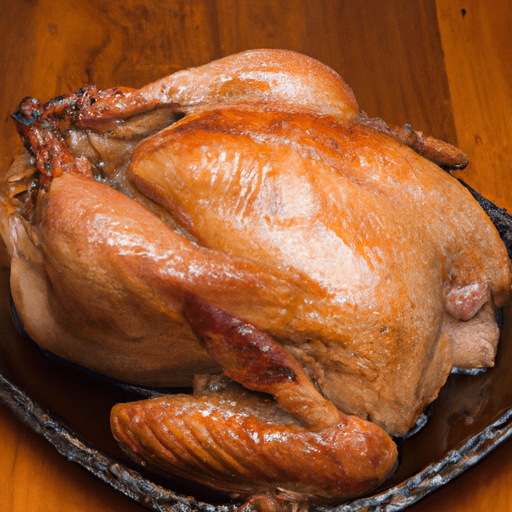The Savory Delight of Roast Turkey Breast
If you’re searching for a mouth-watering dish that effortlessly combines tenderness, flavor, and versatility, look no further than roast turkey breast. Bursting with savory goodness, this succulent cut of meat is a perennial favorite on tables around the world. In this blog post, we will delve into this delectable offering, exploring its taste, common uses in cooking, nutritional value, and uncovering some fascinating history and facts along the way.
A Taste Like No Other
When it comes to flavor, roast turkey breast delivers an unforgettable experience. With each bite, you’ll revel in the richness and juiciness of the meat. The mildly sweet and earthy undertones are further enhanced by the depth of savory flavors. Whether seasoned with herbs, infused with spices, or basted with a tangy glaze, the taste of roast turkey breast is truly incomparable.
Versatile and Appealing
Roast turkey breast is a remarkably versatile culinary ingredient. Its mild taste and tender texture make it an ideal centerpiece for countless recipes. From classic holiday feasts to casual weeknight dinners, this succulent cut never fails to impress. Sliced thinly, it can be used to craft mouthwatering sandwiches or paninis, while thicker slices can anchor a hearty, protein-packed stir-fry. The possibilities are endless; turkey breast eagerly embraces various seasonings and culinary techniques, ensuring a delightful dining experience.
Nutritional Powerhouse
Alongside its sensational flavor and culinary adaptability, roast turkey breast boasts an impressive nutritional profile. It is naturally low in fat and calories while being an excellent source of lean protein. Packed with essential amino acids, turkey breast supports muscle growth and repair – a boon for fitness enthusiasts and health-conscious individuals. Notably, it is also a rich source of vitamins and minerals, including vitamin B6, niacin, selenium, and zinc. With roast turkey breast on your plate, you can savor a tasty meal while nourishing your body.
History and Fascinating Facts
Turkey has a long and fascinating history, dating back to ancient times. Native to North America, it was domesticated by the Indigenous peoples who incorporated it into their traditional cuisine. Later, European explorers brought turkeys back to their homelands, where they gained immense popularity. Today, roast turkey, particularly during Thanksgiving and Christmas, holds a position of honor in many cultures, symbolizing abundance, celebration, and family gatherings.
Did you know that turkey was once considered a luxurious meat exclusive to the upper classes? In the 16th century, Queen Elizabeth I of England is believed to have been the first English monarch to include turkey in the royal Christmas feast.
Another fun fact: turkeys can run at speeds of up to 20 miles per hour and can even fly short distances! These agile birds possess a keen sense of hearing and excellent eyesight, which allows them to steer clear of potential predators.
Roast turkey breast is a culinary masterpiece that satisfies taste buds and nourishes the body. Its sumptuous flavor profile, versatility, and impressive nutritional value make it a clear winner in the kitchen. So whether you’re planning a festive gathering or a simple, satisfying meal, be sure to include roast turkey breast on your menu. It’s a surefire way to create moments of culinary delight and bring people together in the shared joy of good food.
Roast Turkey Breast
Origin: The domestic turkey (Meleagris gallopavo) is native to North America and was first domesticated by Indigenous peoples in ancient Mexico. It is believed that European explorers brought turkeys back to Europe in the early 16th century.
Common Uses: Roast turkey breast is a popular choice for holiday feasts, especially Thanksgiving and Christmas. It is often served as the main protein alongside other traditional holiday dishes. Apart from special occasions, roasted turkey breast is also commonly used as a sandwich meat or as an ingredient in salads, casseroles, and soups.
Nutritional Benefits: Roast turkey breast is a lean source of protein, providing essential amino acids that support muscle growth and repair. It is also low in saturated fat and a good source of several vitamins and minerals, including vitamin B6, niacin, phosphorus, and selenium. It is also relatively low in calories when compared to other meats.
Unique Properties: Turkey breast is known for its mild and versatile flavor. Roasting the breast meat helps to retain its juiciness and tenderness. Turkey breast has a relatively low fat content compared to other cuts of turkey, making it a healthier option for those watching their fat intake.
Historical Significance: Turkey has a long history in North America and was a staple food for many Indigenous tribes. During the 17th century, European colonists in America adopted the tradition of feasting on roast turkey, which led to the establishment of the modern-day association between turkey and Thanksgiving. Today, roast turkey remains an iconic dish in American holiday traditions.
Note: It’s important to note that roast turkey breast is often seasoned and prepared in various ways, so the exact flavor and nutritional profile can vary depending on the specific recipe and ingredients used.




Use the share button below if you liked it.
It makes me smile, when I see it.